Understanding and Troubleshooting Hydraulic Proportional Valves
Since the mid-1980s, proportional valves have become increasingly popular and have replaced servo valves in many applications. The cost of a proportional valve can be as much as 50 percent of the cost of a servo valve of the same size. However, servo valves continue to be used where precise positioning or speed control is required in aircraft, aerospace and turbine generator applications.
Proportional valves can be used as flow and pressure controls, but the most common use is as a directional valve. While the design of proportional directional valves may vary from one manufacturer to another, they all essentially perform the same function: controlling the direction and speed of a hydraulic cylinder or motor. By using feedback devices like linear-displacement transducers or rotary encoders, the position of the actuator can be precisely controlled.

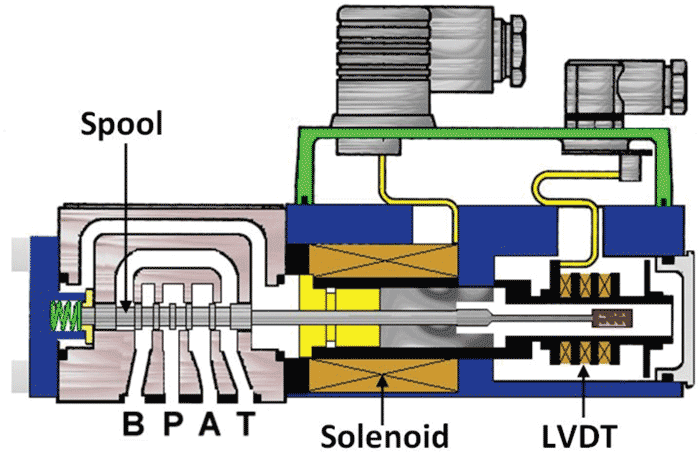
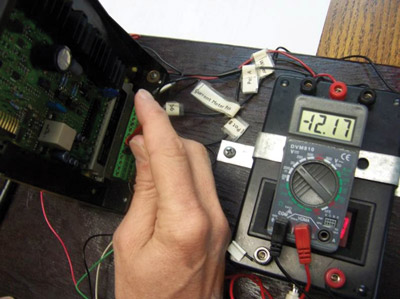 rect-operated Proportional Valves
rect-operated Proportional Valves
Direct-operated proportional valves are used when flow through the valve is approximately 25 gallons per minute (GPM) or less. Two-stage valves, which incorporate a pilot valve and main spool, are used when higher flow rates are required.
In order to troubleshoot the valve and system, you must be able to read hydraulic symbols. In Figure 1, the symbol for a direct-operated proportional valve is shown. Notice the four squares in the symbol. These represent the number of positions in which the valve spool can be shifted. When there is no power to the valve coil, the spring will shift the spool to the position shown on the far left. This is known as the “fail safe” position. In this condition, all flow is blocked through the valve. The symbol for the solenoid indicates that the valve operates off a variable electrical signal. This is usually 0-10 volts or in some cases 4-20 milliamps. The “S/U” symbol on the valve represents the linear variable differential transformer (LVDT), which is used to electrically specify the position of the valve spool. The feedback from the LVDT is normally a direct current (DC) voltage signal. The actual components of the proportional valve can be seen in the valve cutaway in Figure 2.
To operate the valve, an amplifier and power supply are required. The power supply is typically 24 volts and is used to power the amplifier. The command voltage is input from the programmable logic controller (PLC) and determines the position of the valve spool. The “enable” is a relay from the PLC that must be made to send a current signal to the proportional valve coil. In some cases, the enable signal is not used.
When the power supply is turned on and the enable relay is not made, the LVDT will send approximately minus 12 volts back to the amplifier, signifying that the spool is in the “fail safe” position (Figure 3). Once the enable relay is closed, a current signal will be sent to the solenoid. The current creates magnetism in the coil, which pulls in a plunger to shift the spool. Since the command voltage is zero volts, the spool will continue to shift until the LVDT shows that zero volts is fed back. The spool will then be shifted into the “electrically closed” position (Figure 4). Approximately 1.35 amps of current are required to shift the spool into the “electrically closed” position.

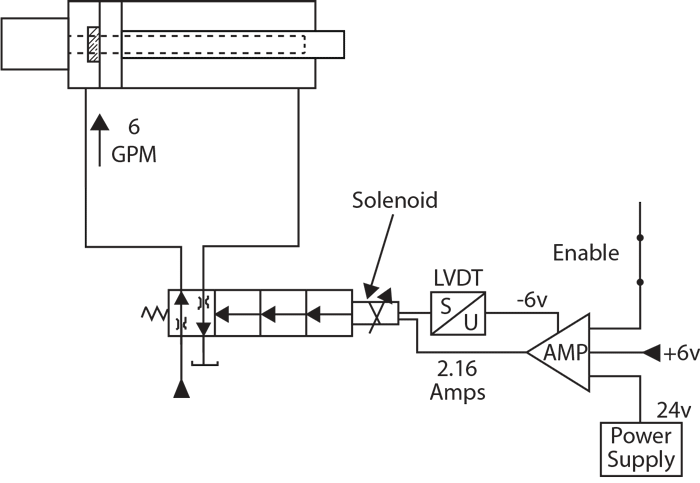
To move the linear positioner 12 inches (Figure 5), a command voltage is input into the PLC. The amplifier converts the command voltage into a current signal, which is applied to the valve coil. A command voltage of 6 volts is input into the amplifier. The amplifier will then send a higher current (2.16 amps) to the valve coil. This shifts the valve spool into the straight arrows position. This position is commonly called the “A” position. The increased current causes the valve spool to shift until the LVDT feeds back minus 6 volts. The spool will then stop shifting and maintain its position. Oil is then directed through the valve spool and into the full piston side of the linear positioner. The speed in which the positioner moves is determined by the amount of spool shift. In this example, if the valve has a maximum flow rating of 10 GPM, then 6 gallons per minute will flow through the spool when shifted with a command voltage of 6 volts.
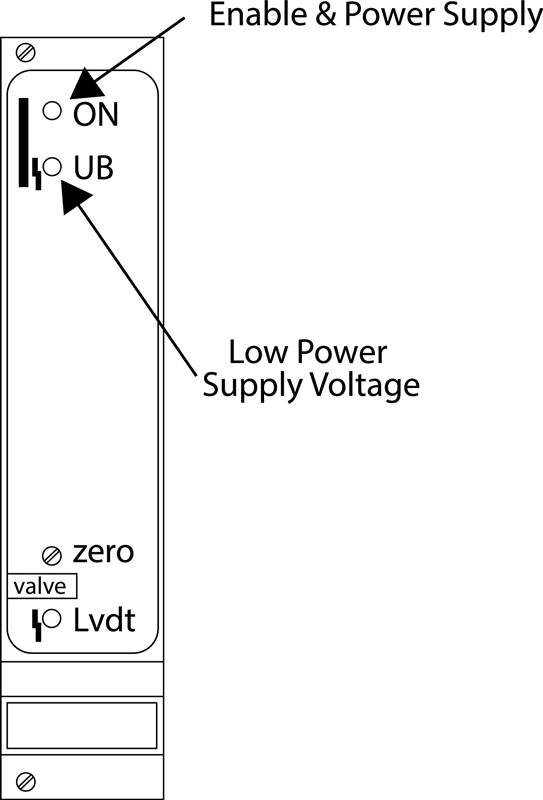
As the cylinder moves, the linear-displacement transducer sends an analog or digital signal back to the PLC. For example, if one digital pulse is sent back to the PLC for every 0.001 inch of movement, the positioner rod will move until 12,000 pulses are fed back, signaling that the positioner has moved 12 inches. The command voltage will then drop to zero, and the proportional valve spool will once again shift into the “electrically closed” position. The cylinder will hold its position until commanded to move to a different stroke.
Troubleshooting the System
If an externally mounted amplifier is used (Figure 6), lights on the front panel will denote a fault in the system. When the power supply is turned on and the enable signal is received, the “on” light will illuminate green. The enable voltage may range from 8.5-40 volts, although 10 volts is common. If the light does not illuminate, the enable and power supply voltages should be checked at the amplifier connections. If no input enable voltage is present, the wiring and output signal should be checked from the PLC.
If the power supply drops below 21 volts, the red “UB” light will come on. This generally means the power supply or wiring is bad. When the power supply is good (Figure 7), 24 volts should be indicated at the amplifier.
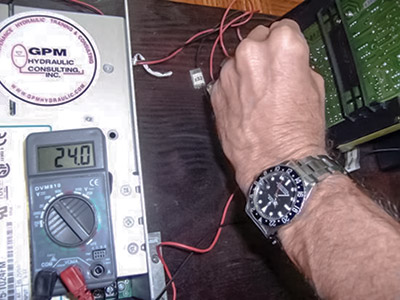 The yellow light on the bottom of the amplifier face is used to show when the LVDT is bad or there is a problem with the connecting cables. The light will glow yellow when any of these elements fails. The easiest way to determine where the failure is occurring is to remove the LVDT cable from the existing valve and plug it into a new valve. It is not necessary to install the new valve for this test. If the yellow light goes out, the LVDT on the old valve has failed and a new valve should be installed on the machine. If the light stays on when plugged into the new valve, the problem is with the cable or connections. The continuity of the cable should be checked. If the light flickers as the machine operates, this normally indicates loose connections.
The yellow light on the bottom of the amplifier face is used to show when the LVDT is bad or there is a problem with the connecting cables. The light will glow yellow when any of these elements fails. The easiest way to determine where the failure is occurring is to remove the LVDT cable from the existing valve and plug it into a new valve. It is not necessary to install the new valve for this test. If the yellow light goes out, the LVDT on the old valve has failed and a new valve should be installed on the machine. If the light stays on when plugged into the new valve, the problem is with the cable or connections. The continuity of the cable should be checked. If the light flickers as the machine operates, this normally indicates loose connections.
The zero adjustment is located on the amplifier’s front face. This adjustment should be made in the event the cylinder is moving with a zero command signal coming into the valve amplifier. If the load is moving, the spool is not in the closed position. This is usually caused by the LVDT being out of position. Rotate the zero adjustment until the linear positioner stops drifting or oscillating.
If speed or positioning problems are occurring, the command and LVDT signals should be checked at the appropriate connections on the amplifier. If these are reading correctly, the problem is most likely in the hydraulic system or the linear positioner.
Valves with Onboard Electronics
A recent trend has been to mount the amplifier on the proportional valve. This is commonly referred to as onboard electronics (OBE). The valve operates the same as described with the external amplifier. The most common type of OBE valve uses a seven-pin connector. The power supply is input in the “A” and “B” pins on the valve. The command voltage comes into the amplifier via the “D” and “E” pins. To check these voltages, a multi-tester can be used by inserting the red and black leads into the appropriate connectors on the cable. To verify the power supply, insert the red lead into “A” and the black lead into “B.” Twenty-four volts should be indicated. To check the command voltage from the PLC, insert the red lead into “D” and the black lead into “E.” A 0-10 volt signal should be shown depending on the command signal from the PLC.
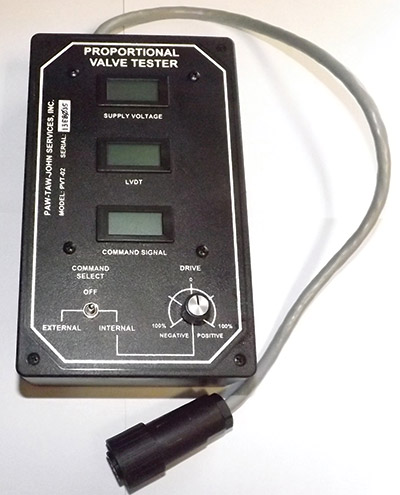 A test box (Figure 8) can also be used to verify that the valve is operating properly. The cable from the PLC should be plugged into the box, and the cable on the box into the proportional valve. When the system is turned on and operating, the power supply, command and LVDT voltages will be indicated. The valve can also be driven with the test box by moving the “command select” switch to internal. The valve can then be driven with the box’s “drive” adjustment.
A test box (Figure 8) can also be used to verify that the valve is operating properly. The cable from the PLC should be plugged into the box, and the cable on the box into the proportional valve. When the system is turned on and operating, the power supply, command and LVDT voltages will be indicated. The valve can also be driven with the test box by moving the “command select” switch to internal. The valve can then be driven with the box’s “drive” adjustment.
If the linear positioner is drifting, the LVDT may not be in the proper position. To null the valve, the LVDT access cover should be removed. The LVDT centering adjustment should then be slowly rotated until the drifting stops.
Oil Cleanliness
Proportional valves have extremely tight tolerances between the spool and housing. These tolerances are typically between 0.0001 and 0.0003 inch. It is essential that the oil entering the valve meet the standard set by the manufacturer. The cleanliness level is determined by the ISO 4406 code for the specific valve. For example, the ISO code for a particular valve may be 17/15/12. The three numbers correspond to the 4-, 6- and 14-micron particles in a 1-milliliter sample taken from the system. The “17” represents that the system has 640 to 1,300 particles that are 4 microns and larger. The “15” means there are between 160 and 320 particles that are 6 microns and larger. The “12” indicates that the sample contains 20 to 40 particles that are 14 microns and larger. It is necessary to use a 3-micron filter with a beta rating of 75 or higher to achieve this level. The oil should be sampled regularly to ensure the system meets this standard. A higher ISO code may mean the filters aren’t being changed often enough, the filters don’t have the proper micron and beta rating, or additional filters may need to be added to the system.
In conclusion, by troubleshooting systems that utilize proportional valves, you can avoid lost production time as well as the unnecessary expense of sending off good valves for repair. Changing out parts that do not need to be replaced can also introduce contaminants into the system, which can lead to even more serious problems. Be sure to follow the steps described in this article before removing any proportional valves from your hydraulic systems.
